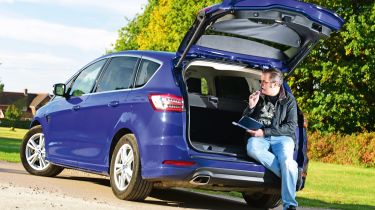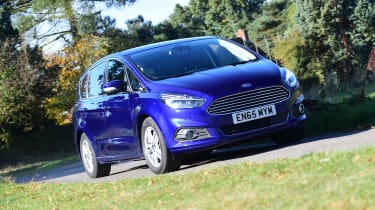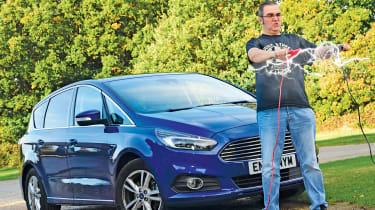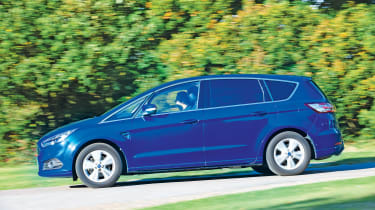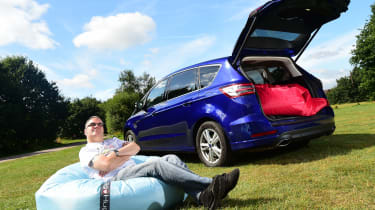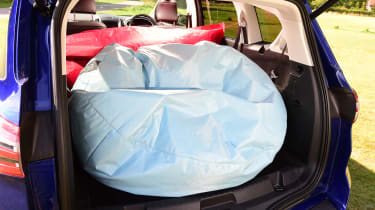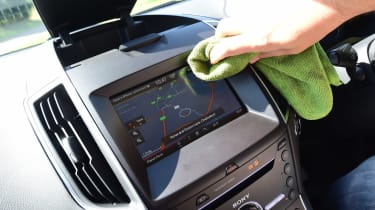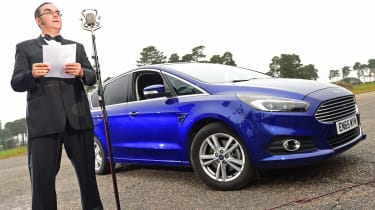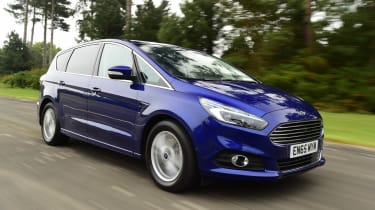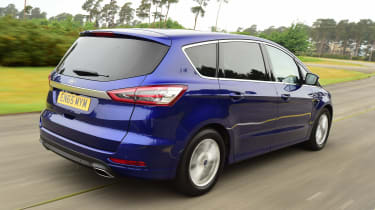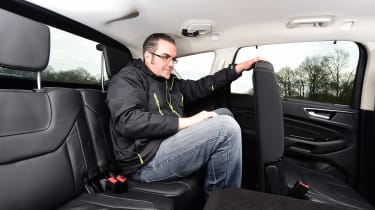Long-term test review: Ford S-MAX
Final report: how has our practical seven-seat Ford S-MAX performed in the past year?

The Ford S-MAX is a good MPV and makes sense if you either regularly carry five people and luggage or need the full seven seats. We’ve loved its cruising ability and lots of the electronic goodies despite some gremlins, but the next Ford on our fleet might have an ‘edge’ that puts it ahead of the S-MAX.
Mileage: 17,236Economy: 36.8mpg
It’s time for our Ford S-MAX to head for pastures new, and I can give my verdict on this MPV and its load-carrying ability.
Overall, the S-MAX has been quiet and superbly refined, and I’ve loved its long-distance cruising comfort and hi-tech goodies. But spending more time behind the wheel of any car can show up its shortcomings, and there are some things about the S-MAX that have left me rather disappointed.
Don’t get me wrong – I think this is arguably one of the best mainstream cars that Ford makes. It’s certainly better than the Mondeo, as well as the largely similar, but more expensive, Galaxy. But you need a very specific kind of lifestyle to make the most of this people carrier.
I must confess that I’ve very rarely used all three rows of seats. Other members of the Auto Express team have reported that the seven-seat set-up is handy if you’re transporting lots of friends, but unless you’ve got more than three kids, or you’re always volunteered to take a big group on an outing, then the back row won’t see much action.
While the third row isn’t as roomy as that of a Citroen Grand C4 Picasso, passenger space in the middle is good. This is where it does fit my lifestyle, as there are IsofiX points on all three of the individually sliding and folding seats, and there is no issue with shoulder space for three adults.
Used - available now

2018 Ford
S-Max
71,417 milesManualDiesel2.0L
Cash £11,187
2019 Ford
S-Max
39,990 milesAutomaticDiesel2.0L
Cash £19,599
2019 Ford
S-Max
53,300 milesManualDiesel2.0L
Cash £16,395
2022 Ford
S-Max
86,020 milesAutomaticDiesel2.0L
Cash £15,995I have no complaints about the amount of boot space on offer, either. I’ve turned the S-MAX into a van numerous times, and a bonus of the heavily tinted rear windows is van-like security; you can’t see what’s inside.
But when you’ve only got a few odds and ends to carry, the sheer size of the boot is also its undoing. There are two lashing eyes, a modest bag hook to one side and a slim underfloor storage area behind the rearmost seats, but that’s it for practical touches. The underfloor storage is awkwardly shaped, and is only really any good for long, slender items, like umbrellas – or baguettes.
What’s more, the extending load cover isn’t really fit for purpose. It’s set back from the middle row seats, so there’s a gap between it and the backs of the chairs in front. The load cover’s sheer length means it’s almost impossible to remove or replace it without scratching the plastic trim in the boot, either, and there’s nowhere to store it in the car when it’s not in use.
Talking of plastics, the cladding in the boot has taken a pounding over the past few months. That’s another side-effect of having too much space to carry a few items, because things slide around on the carpeted floor.
One item that’s been sliding about regularly is a set of jump leads, because the flat battery I reported last time knocked my confidence in the car.
While the S-MAX has started first time every time since, there have been a few electronic concerns that have irritated more than anything. The front collision monitor has been set off by cars turning in front of me, the parking sensors have started beeping furiously in traffic even when you’re not close to the car in front, while the Bluetooth paired with my phone has cut in over the radio with static hiss, even though I’m not making a call.
I can put up with the boot’s issues, but these electrical niggles are harder to swallow.
Ford S-MAX: fourth report
Electrical niggles have taken the shine off our Ford S-MAX MPV
Mileage: 14,883Economy: 44.0mpg
Modern cars have plenty of electronics on board, but as our Ford S-MAX has demonstrated, if they go wrong, they can spoil an otherwise enjoyable ownership experience. Now, I’m still a big fan of our Ford seven-seater, but one episode in particular briefly knocked my confidence.
• Best seven-seaters cars to buy
One morning, I came to the car as usual and pulled on the door handle to unlock it – keyless entry means this is a habit you easily get into – but this time, nothing happened. I checked my pockets in case I hadn’t picked up the key (I had), but even pressing the unlock button failed to unlock the car. Somewhat puzzled, and in a bit of a hurry, I borrowed my wife’s car for the morning and came back to the S-MAX later.
On my return, the first job was to unlock the car manually. This meant I had to prise the cover off the driver’s door lock, then extract the metal key from inside the key fob. Once unlocked, I tried the dashboard starter button, but still nothing happened.
So, I popped the bonnet, and jump-started the S-MAX using my wife’s car. It took a couple of cranks before firing, which told me the battery was flat. But why had this happened? After all, I’d only been using it the day before, so it should have started straight away.
As it transpired, it was the car’s USB socket that was the culprit. I had a charging lead plugged in – albeit without anything connected at the other end – and it turned out that it was drawing current even with the ignition turned off. The drop in voltage also explained a couple of other niggles that I’ve come across.
Firstly, the car switched temperature readings from Celsius to Farenheit without prompting, while the parking sensors changed their beeping tone. The latter was particularly strange, because I’ve yet to find a menu in the car’s settings that allows you to do that…I now ensure that the two USB sockets don’t have anything plugged into them when I leave the car, and the flat battery issue hasn’t returned. The S-MAX even started first time after almost a week parked up, although I’ve left a set of jump leads in the boot just in case.
Aside from this, it’s been plain sailing with the big seven-seater. With the nights drawing in, I’ve been using the adaptive LED headlights more, and am still impressed by their effectiveness. Even in dark, foggy conditions they work well, reacting to oncoming cars and dipping automatically in plenty of time.
The trip computer has been holding steady at 41mpg for thousands of miles now, meaning we’re unlikely to get any better economy from it. So I’ll just carry on enjoying its comfortable ride and plush drive, electronic gremlins permitting.
Ford S-MAX: third report
A long-haul trip to Scotland proved just how comfortable our Ford S-MAX MPV is
Mileage: 10,832Economy: 34.3mpg
Over my time with the Ford S-MAX I’ve come to love its blend of space, tech and easy driving, but surely a seven-seat MPV should be comfortable, too?
It’s one area I’ve only briefly touched upon during my time in the big blue people carrier, but the Ford certainly excels here. I recently made the long trip from Essex to Scotland for the Edinburgh Festival Fringe and came to the conclusion that, if you’re heading to a festival, the S-MAX might just be the perfect car for the job.
Stick with me, because the space inside the cabin means you can easily bung a few beanbags in the back for extra comfort when you reach your campsite or destination – and you’ll be in plenty of comfort on the move, too, thanks to the Ford’s compliant chassis.
There’s room to spare in the back, so even when you get to the festival campsite, if the conditions aren’t so favourable the well insulated cabin means you could easily turn the boot into a bedroom for the night.
The cabin is quiet on the move thanks to acoustic glass for the side windows, which blocks out wind and road roar. The trip up to Edinburgh was a relaxed journey because of it, and with only the distant thrum of the punchy 2.0-litre turbodiesel under the bonnet, I arrived in the Scottish capital relaxed and ready to go and see a show.
Adaptive cruise control was a big boon on the journey, managing the accelerator and brakes in fast-flowing but busy traffic. However, if I have one criticism of the system, it would be that if the radar sensor doesn’t spot a car ahead of you early enough, it can be a little jerky on the brakes as it slows the vehicle down.
Another niggle I’ve had with the car relates to what I’ve come to call its ‘haunted door bins’. There’s a rattle that seems to emanate from all of them, but it doesn’t happen all of the time and can occur when it’s just me on board or when I have a full load of passengers and luggage in the boot. It’s all the more noticeable given the impressive refinement on offer, too.
It didn’t detract from the car in Edinburgh, though, as the Ford’s supple dampers soaked up the cobbled streets and generally poor road surfaces around the city well. It’s a real test of any car and the S-MAX proved capable.
The £400 front camera has been a godsend when it comes to parking, too, as the optional self-parking system (a £150 extra) has failed a couple of times to pick up spaces that are big enough – maybe it’s a shortcoming that the software can’t cope with spaces a few inches longer than the car.
So the S-MAX has proved easy to live with, with its comfort and refinement making it the perfect companion for a festival trip.
However, Fords have always been great to drive, too, but the trade-off for this refined ride is that the car feels heavy under braking and in corners. There’s pronounced body roll in bends and the S-MAX uses its brakes quite hard even under normal use, which leaves them dirty with dust most of the time.
Ford S-MAX: second report
Seven-seat Ford S-MAX’s impressive voice recognition tech puts our man in presenter mode
Mileage: 5,929Economy: 37.6mpg
Whenever I take the wheel of our Ford S-MAX, I have this uncontrollable urge to do an impression of an announcer from the pre-war British Broadcasting Corporation. I clear my throat, practise my best Received Pronunciation and speak clearly and authoritatively, even when there’s nobody else in the car with me.
Have I lost the plot? Some might say I never had it in the first place, but what I’m doing is taking advantage of Ford’s SYNC voice recognition software, which is standard on our S-MAX. It’s designed to make life easier for the driver, as you press a button on the steering wheel and speak commands that the SYNC software recognises, instead of trying to fiddle with the buttons on the dash, which can distract you from driving.
You can wow passengers by talking to the car and have it obey your commands as a female voice responds, although it only works with a list of pre-prepared phrases that the system understands. The list of phrases is pretty comprehensive, though, and you can control the temperature, make phone calls, set a sat-nav destination and select music this way. One source of amusement is to ask SYNC ‘What’s playing?’ when listening to music – the system’s set phrasing means some artists and song titles can sound pretty bizarre when compared to their normal pronunciation.
While I feel the need to speak clearly – maybe having to deal with automated call centres has conditioned me – I have tried to test the system by mumbling commands. I’ve also put on different foreign and regional accents (making sure nobody is within earshot!), yet you have to be really incomprehensible for the system to trip up.
It’s all very impressive, but there are some frustrations. First up, although you can make phone calls, there’s no facility to read out or compose text messages, while other makers already offer this function.
Another is the length of time it takes to use SYNC – each time you want it, you press the button on the wheel, wait for the automated voice to say: ‘Please say a command’ (although you can skip this by pressing the button again), wait for the beep, speak your command and pause until the system acknowledges you. As there’s a big volume knob and temperature buttons within easy reach on the dash, it’s quicker to use those rather than SYNC. Also, the system isn’t very good for zooming in on the map, as it only works one step at a time – the screen buttons are quicker to use, even though they’re fiddly.
As far as niggles go, these issues with SYNC are pretty small, and I guess that goes to show how much I rate the S-MAX. It’s comfortable and easy to drive, and the seven-seat layout has proven its worth, too.
The longer days mean I haven’t had to use the car’s adaptive LED headlights quite as often, which is a shame because they’re excellent. They’re so good that I’ve left them on main beam since I first used them, and not once has an oncoming driver flashed me to tell me I’m dazzling them.
It’s so far, so good for the S-MAX, then, and I’m looking forward to taking it on a couple of longer trips over the summer, especially as they should improve on the less than great 37.6mpg I’m getting from it. While I’m away, I might rope in some locals to try a few more regional dialects, too, and really push the SYNC system to its limits...
Ford S-Max: first report
Will our new S-MAX show that one car is a better option than two for a growing family?
Family life can be pretty demanding at the best of times, so I'm hopeful that our new Ford S-MAX will be a useful addition to the Gibson clan. However, it did get me wondering: are two cars better than one for a busy family? To help answer the question, I gave my mate Adam a bell to gather together our respective families and motors for an impromtu group test.
You see, Adam runs a Ford Mondeo, while his wife Debs drives a B-MAX, and they use both their cars to ferry their daughters Grace and Faith around on journeys short and long. Me? Well, I've got my wife Lynn and son Rhys, and while we have a similarly busy schedule, with just the S-MAX to hand, there are a few compromises to be made.
Thankfully, one that you don't need to make is on load-lugging. With a maximum capacity of 2,020 litres, the S-MAX's big, boxy body has far more space than you get in a Mondeo, and while the folding back seats are similar to the B-MAX's, you get two extra cairs in the boot. These rearmost seats mean that all seven of us could head out in one car, while the three sets of Isofix mounts in the middle row ensure the kids are secure in their child seats, too.
Access to the cabin is trickier than in the B-MAX, because the latter's sliding doors mean it's easy to get in and out of the back. In fact, it's a bit of a surprise that neither of Ford's big MPVs, the S-MAX or Galaxy, has sliding doors, seeing as the B-MAX and seven-seat Grand C-MAX come with them.
What the S-MAX isn't lacking is standard kit. The cabin takes inspiration from the Mondeo, and as both Adam and I are running Titanium X models, it's only the S-MAX's elevated driving position and more upright dashboard that differentiates the pair.
That means you get loads of standard kit, including Ford's latest touchscreen nav, although that does show up fingerprints rather easily. Our car's X pack is a pricey add-on at £2,225, but it includes heated leather seats with electric adjustment and memory function for the driver's seat, and adaptive LED headlights. I've been very impressed with the headlight system, because you can leave it on main beam at night and it automatically picks out other traffic and dips only a section of the beam, leaving the surrounding area illuminated.
Our S-MAX uses the more powerful 178bhp version of Ford's 2.0 TDCi diesel, and is paired with a six-speed Powershift auto. It packs plenty of punch, while a few lengthy runs have seen economy come in at 37.2mpg.
Still, the engine is quiet and refined, and combined with soft suspension, the S-MAX is a pretty comfortable cruiser. We've added adaptive cruise control to our car, which comes with active city stop, for £900. It takes the strain out of long-distance travel, and the S-MAX is proving quiet and refined.
The only real quibble with our new arrival is its sheer size. There's no doubt a B-MAX is far easier to park, but at least the S-MAX gets front and rear parking sensors as standard. We've added front and rear cameras for £400 and park assist for £150 for extra peace of mind, but the S-MAX is undoubtedly a bit of a beast to park. Still, it's easier than finding space for two cars.

